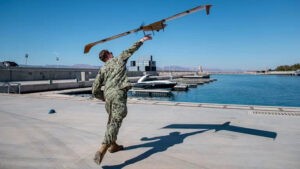The small electronics company "Marine Instruments" actually started out in 2004 with data-transmitting buoys for fishing and small boats, but has since catapulted itself to the top of European manufacturers of niche maritime products. The company, which is based in Nigrán/Pontevedra, south-west of Vigo in the northern Spanish region of Galicia, is now part of the Spanish technology cluster Groupo Arbulu.
In the beginning was the tunadrone
Thanks to its "Tunadrone", which has been used in commercial fishing (tuna) since 2019 and is able to distinguish between fish and seabirds, and its further development into the M5D-Airfox, which is successfully used in Spain's waters for fisheries surveillance and maritime traffic control, it is not only the US Navy that is currently interested in the easy-to-operate solar bird. After this drone was successfully tested in April 2022 during the international, US-led Maritime Exercise 2022 "Cutlass Express" in Jordan with around 70 other devices, the Spanish Armada has finally approved the purchase of three units for 1 million euros - customs, fisheries control and Guardia Civil del Mar have been using this drone for their tasks for some time. The Armada wants to use it specifically for mine hunting - of course it also recognises divers and objects under the surface!

M5D-Airfox
The drone measures 2.5 metres in wingspan and one metre in length, its fixed wings are paved with solar cells. It reaches a speed of 55 kmh/33 knots and can also withstand a moderate breeze (BF 5, i.e. 27 to 35 kmh / 16 to 21 knots of wind). Its endurance is up to 10 hours with a range radius of 30 kilometres. Thrown against the wind with a little run-up - caught again with a net that can be stretched. It works!











One Response
This is a super exciting article! What drones are used for!